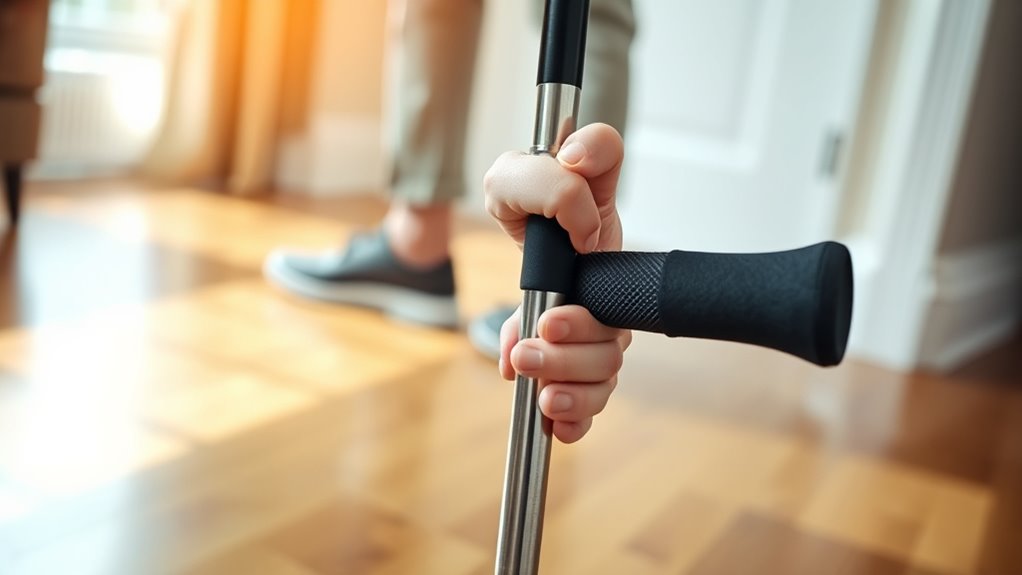When choosing a cane, focus on an ergonomic handle that feels comfortable and fits naturally in your hand to reduce strain. Adjust the height so the top aligns with your wrist crease and allows a slight elbow bend for comfort. Opt for lightweight materials like aluminum for easy maneuverability. Make sure the cane fits well and provides stability, especially on uneven surfaces. If you keep these tips in mind, you’ll find the perfect fit and support tailored to your needs.
Key Takeaways
- Select an ergonomic handle that fits comfortably and reduces hand strain during extended use.
- Adjust the cane height so the top aligns with your wrist crease for proper posture.
- Choose lightweight materials like aluminum or carbon fiber to minimize fatigue.
- Ensure the cane allows a slight elbow bend (15-30 degrees) for comfort and support.
- Test the fit by walking a few steps to confirm stability, comfort, and upright posture.

Choosing the right cane is vital for maintaining stability and confidence while walking. When you’re shopping for a cane, pay close attention to ergonomic handles, which are designed to fit comfortably in your hand. An ergonomic handle reduces strain and discomfort, especially during extended use. Look for a cane with a handle that contours to your grip, providing better support and control. This feature is particularly beneficial if you experience hand pain or joint issues, as it helps distribute pressure evenly and minimizes fatigue.
Choose a cane with an ergonomic handle for better comfort, support, and reduced strain during extended use.
Another critical aspect is the adjustable height feature. No two bodies are exactly alike, so a cane that can be tailored to your specific height ensures proper posture and balance. When selecting a cane, stand upright in your normal walking posture and let your arms relax at your sides. The top of the cane should align with the crease of your wrist, allowing your elbow to bend slightly—about 15 to 30 degrees—when you hold it. An adjustable cane makes it easy to fine-tune this length, giving you a customized fit that promotes comfort and safety.
Beyond ergonomic handles and adjustable height, consider the material and weight of the cane. Lightweight materials like aluminum or carbon fiber make it easier to maneuver without sacrificing durability. A lightweight cane reduces fatigue, especially if you need to use it for extended periods. Check the cane’s base as well—rubber tips provide better grip on various surfaces, reducing the risk of slips and falls. Some canes come with a wider or more textured tip for added stability on uneven surfaces.
When you’re trying out a new cane, test its stability and comfort. Hold it firmly, and walk a few steps to see how well it supports your weight. Make sure the handle feels natural in your hand and isn’t causing discomfort or pinching. If the cane is adjustable, tweak the length and test again to find that perfect fit. Remember, a properly fitted cane should allow you to walk upright without leaning or hunching forward.
Additionally, consider the material and weight of the cane, as these factors greatly influence ease of use and fatigue during extended periods of walking. Choosing the right cane isn’t just about style or brand; it’s about making sure it fits your body and your needs. Focus on ergonomic handles and adjustable height to guarantee comfort, safety, and confidence with every step. Investing a little time into selecting the proper cane makes a big difference in your mobility and independence. When fitted correctly, your cane becomes more than just support—it becomes a reliable partner in your everyday mobility. Properly choosing and fitting your cane can also help prevent discomfort and injury during use.
A well-selected cane can also incorporate safety features, such as reflective strips or rubber tips, to further enhance stability and visibility in various environments. Additionally, selecting a cane with features like non-slip tips can significantly improve safety on wet or uneven surfaces.
Frequently Asked Questions
How Often Should I Replace My Cane?
You should replace your cane when you notice signs of wear, such as cracks or loose parts, which affect cane durability. If your cane’s ergonomic design no longer feels comfortable or supportive, it’s time for a new one. Regularly inspecting your cane guarantees it provides proper support and safety. Typically, replacing it every 1-2 years is recommended, but frequent use or damage means sooner replacement might be necessary to maintain stability.
Can I Customize My Cane’s Height?
Yes, you can customize your cane’s height with adjustable canes, making it easy to get the perfect fit. Adjustable canes feature a simple mechanism that allows you to change the height easily, ensuring better support and comfort. When choosing a cane, look for adjustable options to match your specific needs, and always double-check the settings for stability before use. Customization helps you stay safe and comfortable daily.
Are There Lightweight Canes for Long-Term Use?
Imagine gliding effortlessly with a lightweight cane that feels like a natural extension of your hand. Yes, there are lightweight canes designed for long-term use, featuring an ergonomic grip and adjustable length for personalized comfort. These canes reduce fatigue and strain, making daily mobility easier. Opt for models made from durable yet lightweight materials like aluminum, so you stay supported without feeling weighed down, no matter how long your day lasts.
What Maintenance Does a Cane Require?
You should regularly maintain your cane by cleaning it to keep dirt and germs away. Wipe down the shaft and handle with a damp cloth, especially if you use it daily. Check the handle for comfort and adjust it if possible for a secure grip. Also, inspect the rubber tips for wear and replace them when worn out. Proper maintenance guarantees your cane stays safe, clean, and comfortable for long-term use.
How Do I Know if My Cane Provides Proper Support?
Imagine walking confidently with your cane, feeling steady and supported. To verify if it provides proper support, check if the ergonomic grip feels comfortable and secure in your hand. Confirm the cane material options, like lightweight aluminum or sturdy wood, match your needs. When you use it, your weight should distribute evenly without wobbling or pain, indicating your cane offers the right support for your balance and safety.
Conclusion
Now that you know how to choose the perfect cane, you’ll be unstoppable! Imagine walking with such confidence that even the strongest gusts of wind can’t knock you over. Your cane will become your trusty sidekick, turning every step into a victory dance. Don’t settle for less—pick the right fit, use it wisely, and watch your independence soar like an eagle. The power to move freely is in your hands—literally!









